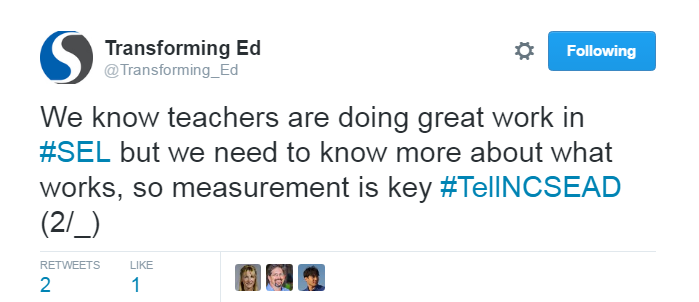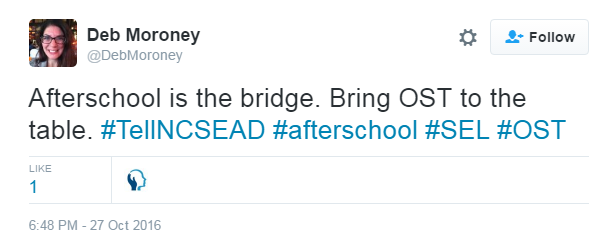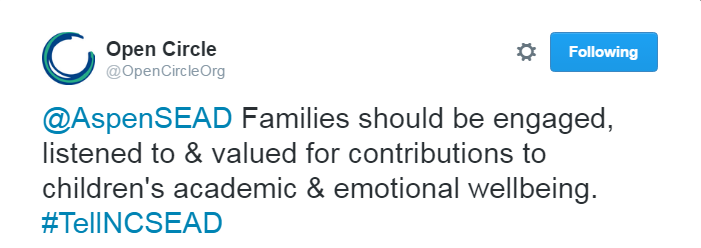#TellNCSEAD
During the weeks immediately before and after the Commission’s inaugural meeting, we ran a social media campaign to gather insights and perspectives on how to re-envision success for our schools. Using the hashtag #TellNCSEAD on Twitter and Facebook, we solicited open-ended feedback for Commissioners’ consideration. The campaign has reached 75,228 people, generated more than 100 tweets, and resulted in 350 visits to the Commission website. Below is a brief synopsis of what people are saying.
Educator Preparation and Professional Development
Commenters emphasized the need to prepare and support teachers in addressing the full development of their students. They noted that educators should receive explicit and specific training on both integrating SEAD into teaching and learning (e.g. culturally responsive teaching, personalized instruction) and shaping the school environment so that it promotes students’ holistic development (e.g. relationship development, creating an emotionally safe and supportive classroom culture).
Some participants pointed out that teachers’ own social and emotional needs must be met so that they can facilitate such growth in their students.
Others noted the importance of providing training to administrators, as well as teachers, and tapping into the expertise of school counselors who have years of experience helping students build these skillsets.
Example:

Teaching and Learning
Many responses focused on the need to integrate SEAD into everyday lessons and school culture, emphasizing that addressing students’ social and emotional growth shouldn’t be just a standalone program. But participants also noted that schools can and should devote specific time and attention to social and emotional development.
Some responses focused on the need to develop clear plans for helping students build social and emotional competencies, and to ensure that those plans also support academic development.
Commentors noted that “rapport” and relationships are prerequisites for SEAD success and that students cannot be told what they are supposed to learn or feel. As such, experiential learning and facilitated discussion is more valuable than traditional lecture-style teaching.
Example:

Measurement
Respondents agree that measurement of SEAD skills is an area where more work needs to be done for multiple reasons: to better understand student strengths and areas for growth, to determine what strategies and practices are most effective, and to elevate and legitimize the importance of focusing on social and emotional growth.
Other feedback in this area focused on the limitations of self-reports, the need to primarily use SEAD measures for formative assessment and continuous improvement rather than high-stakes accountability, and the importance of streamlining measures.
Example:

Partnerships
Many commenters emphasized the need to engage with others beyond school walls. This includes working with families to understand what they’re hearing or seeing regarding social and emotional development and to gain essential insights about their children’s social and emotional growth. It also involves working with afterschool/out-of-school providers who play a big role in students’ lives and can build on the SEAD students receive in school.


Additional Highlights
- Multiple respondents emphasized that play is crucial for fostering SEAD. They noted that play engages kids and teaches empathy, teamwork, self-regulation, focus, conflict resolution, and more.
- Grassroots experience of SEAD can be more powerful than policy mandates in spurring change. Doing this well requires a real culture shift, in and out of the school building.
- The importance of SEAD shouldn’t just be framed in terms of being employable 10 years from now, but also as a way of answering “How am I going to be better today (or tomorrow)?”
- Creating healthy school climates is an effective strategy for fostering SEAD.
- Technology can be used to facilitate SEAD, but it’s not a silver bullet.

